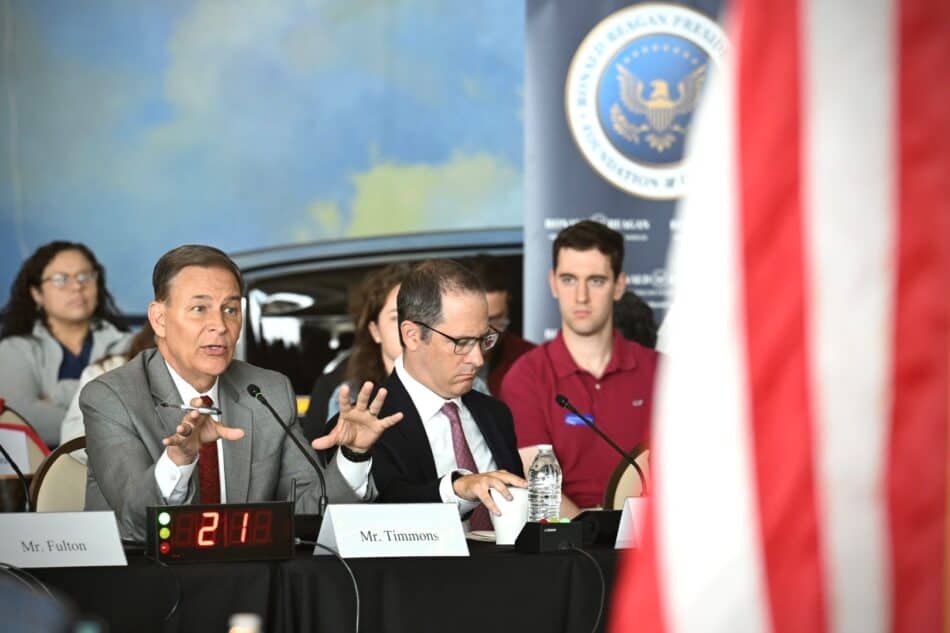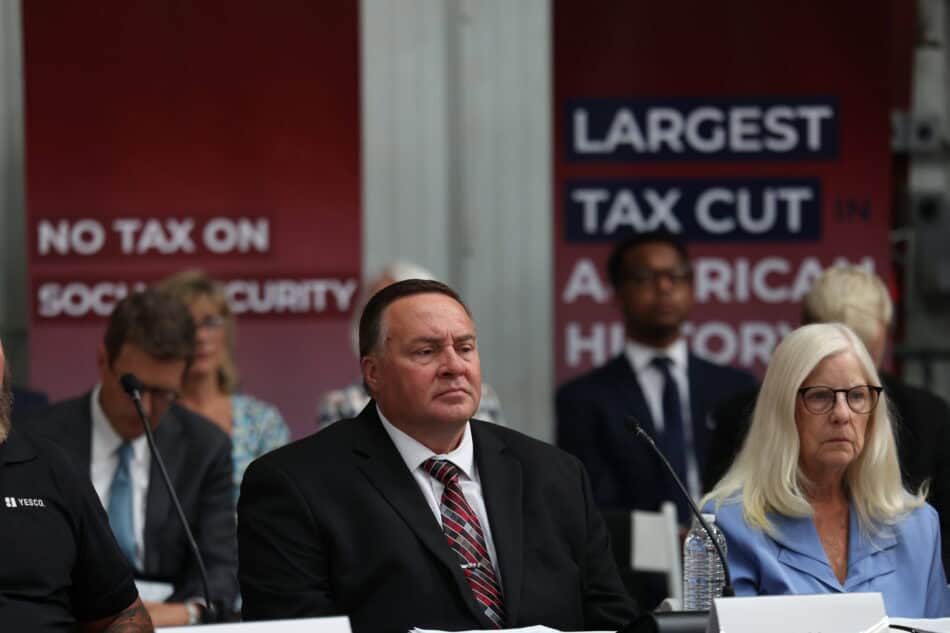NAM Gives DOE Recommendations on Critical Materials

To secure the stable, diversified critical materials supply chains that the U.S. needs to remain globally competitive and achieve energy dominance, changes must be made to the 2026 Energy Critical Materials Assessment, the NAM said today.
What’s going on: “Manufacturers in America utilize critical materials and minerals extensively, deploying them in a wide array of manufactured products throughout the U.S. economy,” NAM Vice President of Domestic Policy Chris Phalen told the Department of Energy in response to a request for information seeking public input on the assessment.
- The NAM recommended the DOE take certain steps regarding the assessment, including adding certain materials to its list and ensuring others remain on it. It also urged the DOE to collaborate with other agencies and Congress to “streamline permitting processes to ensure greater domestic access to these materials.”
Other actions: The NAM also urged the DOE to:
- Maintain “the critical materials that are currently listed within the DOE’s Energy Critical Materials Assessment,” including aluminum, cobalt, copper, electrical steel, lithium and graphite;
- Add iron nitride and zirconium to the assessment;
- Remove permitting barriers that are “restricting the United States from being able to mine, process and access domestic resources, modernize infrastructure and shore up supply chains”;
- Offer financial tools—including investment tax credits, production tax credits and grants—to help “de-risk technological advancement”;
- Align the DOE’s critical materials list with the U.S. Geological Survey’s separate critical minerals list; and
- Add fluorine to the USGS list.
The final say: These recommendations will “ensure [that] manufacturers of all sizes and in all segments of the industry have access to the materials necessary for modern, innovative manufactured products,” Phalen continued.
- They will also allow manufacturers to do what they “do best—put more Americans to work, more factories into motion, more innovation into the marketplace and more investments into our communities while strengthening the hand of the United States on the world stage.”
ICYMI: One Big Beautiful Bill in Action: House Ways and Means Hears from Manufacturers

Watch Jay Timmons’ House Ways and Means Testimony
Over the course of two days, manufacturers praised the pro-growth tax provisions of the One Big Beautiful Bill Act during field hearings hosted by the House Ways and Means Committee. On Friday, Click Bond Director of Manufacturing Austin Robinson testified in Las Vegas, Nevada. On Saturday, National Association of Manufacturers President and CEO Jay Timmons and Robinson Helicopter Company Vice President of Business Development William Fulton testified at the Ronald Reagan Presidential Library in Simi Valley, California. Timmons also joined NewsNation ahead of the hearing to discuss the passage of historic tax legislation.
NAM’s Timmons: Manufacturing Law Will Help to Drive Another American Century
“This is a manufacturers’ law, through and through. By making immediate R&D expensing, full expensing of capital equipment and interest deductibility permanent, this Manufacturing Law delivers for investment and innovation.
…
“Through the pass-through deduction, reduced individual tax rates and estate tax protections for family-owned businesses, this Manufacturing Law delivers for the small businesses that power our economy.
…
“Through protecting the 21% corporate tax rate—and through strengthening the international tax system that incentivizes companies to invest here, build here [and] hire here—this Manufacturing Law will help to deliver another American century.”
Robinson Helicopter: OBBBA Accelerates Domestic Investment, Expansion and Growth
“Many of our employees come from families who have worked at Robinson Helicopter across multiple generations, and we are proud of the work we do, which the One Big Beautiful Bill Act supports by driving our ability to accelerate domestic investment, expansion and growth.
….
“The One Big Beautiful Bill retained a 21% corporate tax rate that underpins the baseline for our global competitiveness, and included critical provisions to reduce the cost of investment that will facilitate our product and job growth plans. Manufacturers are innovators, and one of the most important provisions of H.R. 1 is the restoration of immediate R&D expensing. Though manufacturing accounts for only 10% of the country’s GDP, we make up 53% of all private-sector research spending. These tax provisions help us to invest both in the design of new technology and its production processes.
…
“Thanks to your leadership, Congress and the administration have empowered Robinson Helicopter to create jobs, invest in equipment, innovate through R&D and drive economic growth faster.”

Click Bond: OBBBA Bolsters Family-Supporting Careers
“The One Big Beautiful Bill’s impacts on manufacturing workers [are] substantial. It protects them from tax hikes, provides further cuts via no tax on overtime and frees up capital for businesses like Click Bond to hire more workers [and] increase wages and benefits. By recognizing the importance of innovation, investment and workers, this bill gives manufacturers in Nevada and across the country the tools they need to succeed and grow. This means more jobs and higher wages and more lifelong family-supporting careers for manufacturing workers across this great country.”

NAM’s Timmons: Tax Law Is a Once-in-a-Lifetime Investment
“Manufacturers have been given an incredible opportunity with this tax law … I think this is once in the lifetime of the country that we’ve seen something that is this competition-focused—allowing us to attract investment to our shores. So Chairman Jason Smith … he understands that when you create the economic conditions, then businesses, and specifically manufacturers in our case, can help provide opportunities to folks all across this country … So we’re pretty excited about the ability to do that, and we’ve been given the tools to do that, and I can assure you that manufacturers will live up to that promise.”
-NAM-
The National Association of Manufacturers is the largest manufacturing association in the United States, representing small and large manufacturers in every industrial sector and in all 50 states. Manufacturing employs nearly 13 million men and women, contributes $2.90 trillion to the U.S. economy annually and accounts for 53% of private-sector research and development. The NAM is the powerful voice of the manufacturing community and the leading advocate for a policy agenda that helps manufacturers compete in the global economy and create jobs across the United States. For more information about the NAM or to follow us on Twitter and Facebook, please visit www.nam.org.
EQT’s Rice: U.S. Energy, AI Dominance Require Permitting Reform

To win the artificial intelligence race with China and better compete with Russia, the U.S. must reduce its project-approval times, the head of the largest American natural gas company has warned Congress (Financial Times, subscription).
What’s going on: “Congress [needs] to step up and act,” EQT President and CEO Toby Rice told the FT regarding the need for the government to streamline “America’s byzantine permitting process,” which has greatly increased infrastructure project costs and times.
- “The threat of not getting infrastructure built has only gotten larger,” he continued. “Not only from bad actors getting rich by selling energy that could be replaced with American energy—it’s also the threat of China winning the AI race.”
- The biggest concern, according to Rice: judicial review, which allows for up to six years of legal challenges of permit decisions.
We need it all: In recent years, the U.S. has been shuttering baseload power plants and making it harder for companies to build natural gas infrastructure, Rice continued, and as a result, prices have risen and the electrical grid is becoming unreliable.
- Since the start of his second term, however, President Trump has prioritized making the U.S. energy dominant, taking actions like lifting the previous administration’s ban on new LNG export permits.
The backdrop: “These actions come as the U.S. races to meet growing domestic and global power demand caused by the data centers used to build and develop AI.”
- Global electricity demand from data centers is expected to double by 2030, according to the International Energy Agency.
A positive step: This week, EQT “signed an agreement in principle to provide gas to a 4.4[-gigawatt] plant that will power the Homer City Energy Campus, a 3,200 acre data center in Pennsylvania.”
Europe, too: Europe has been trying to wean itself off Russian gas since Russia’s invasion of Ukraine in 2022.
- This week, ENI—one of Europe’s biggest energy firms—signed an agreement to purchase 2 million metric tonnes of LNG from U.S. company Venture Global.
The NAM’s view: “Mr. Rice is right that, as the NAM has long said, the U.S. permitting system is holding us back,” said NAM Vice President of Domestic Policy Chris Phalen.
- “The administration has made important strides in cutting needless red tape, but manufacturers need comprehensive permitting reform legislation from Congress that supports all energy sources and makes improvements to our transmission and distribution systems for the nation to reach its full potential.”
Using Traditional Energy to Generate Geothermal Power

Researchers seeking new methods of generating thermal energy are now trying something new: the oil and gas industry (POLITICO’s E&E News).
What’s going on: “State research officials in North Dakota are examining two new options—pairing geothermal with active oil and gas sites and using captured carbon dioxide as a feedstock for geothermal power production.”
- The state gave the go-ahead in June for a $250,000 feasibility study looking at “whether those two new geothermal technologies could be used” there.
Why it’s happening now: President Trump signed an executive order in April, calling for the elimination of “all illegitimate impediments” to the development of geothermal projects.
- Geothermal power enjoys bipartisan support in Congress, and federal tax incentives for both geothermal and carbon capture and storage have “created an environment where companies and researchers can start to explore different methods of production,” Matt Villante, an earth scientist with the Pacific Northwest National Laboratory, told E&E News.
- In addition, the 45Q tax credit, which offers an incentive for carbon management undertakings that capture carbon dioxide, was preserved in the recent reconciliation bill.
How it works: Researchers are exploring several different methods for using captured carbon dioxide to produce geothermal energy, which is traditionally extracted “by drilling and pumping up brine from deep within the earth.”
- One method would involve injecting large amounts of carbon dioxide into the ground to push out the brine.
- “Another approach could be pushing CO2 underground to the heat source, and pumping back up the heated CO2 to power the turbines, then injected the cooled carbon dioxide back underground in a closed-loop system.”
- A third way would use hydraulic fracturing to break up “hot dry rock” using carbon dioxide.
Yes, but…Despite the support for geothermal, actual projects to harness it are thin on the ground.
- In 2023, only about 0.4% of U.S. power came from geothermal sources, according to the U.S. Energy Information Administration, as “investors … [wait] for the existing technology to become safer bets.”
The NAM says: “While geothermal represents a small portion of the energy mix now, the NAM supports efforts to invest in developing the technology so that the U.S. has more sources in its all-of-the-above energy portfolio,” said NAM Director of Energy and Resources Policy Michael Davin.
White House AI Plan Reflects Manufacturers’ AI Priorities
Underscores How Manufacturers Are Already Leading in AI Innovation
Washington, D.C. – Following the release of the White House’s AI Action Plan today, National Association of Manufacturers President and CEO Jay Timmons issued the following statement:
“Reflecting President Trump’s vision for the United States to lead on artificial intelligence, the White House’s AI Action Plan underscores what manufacturers across the country already know: AI is no longer a future ambition—it is already central to modern manufacturing. For years, manufacturers have been developing and deploying AI-driven technologies—machine vision, digital twins, robotics and more—to make shop floors safer, strengthen supply chains and drive growth.
“Manufacturers have been leading the charge to shape AI policy that accelerates innovation while ensuring appropriate guardrails. The White House’s plan reflects many of the recommendations we’ve put forward—from permitting reform for all energy sources so we can unleash American energy dominance, to a smarter, more targeted regulatory approach, to supporting workforce development and ensuring small and medium manufacturers can access these technologies. With nearly 400,000 open jobs in manufacturing, we need to invest in the workforce of tomorrow—training existing workers to use AI technologies and attracting new high-skilled talent into the sector.
“We’ve been calling for a pro-AI policy environment—one that supports innovation and responsible integration of AI into real-world operations. That means not rushing to impose burdensome laws or regulations when workable rules already exist. It means adopting requirements that are tailored to specific use cases of AI. It also means light-touch regulations that limit compliance costs so small and medium-sized manufacturers aren’t locked out of this technology.
“The White House plan answers that call.”
Background:
Manufacturers have been at the forefront of developing and implementing cutting-edge AI systems that are transforming shop floors and revolutionizing operations.
In March, the NAM submitted comments to inform the White House’s development of an AI Action Plan, explaining how manufacturers are using AI on shop floors and in operations, with specific recommendations on rebalancing and right-sizing AI regulations to enhance America’s global AI dominance.
In May, the NAM proposed a series of policy recommendations for policymakers to drive AI development and adoption in manufacturing, and the Manufacturing Leadership Council, the digital transformation division of the NAM, released a groundbreaking report, “Shaping the AI-Powered Factory of the Future,” revealing that 51% of manufacturers already deploy AI in their operations, and 80% say AI will be essential to growing or maintaining their business by 2030. This is not just about efficiency—it’s about competitiveness, innovation and the future of American industry.
In May 2024, the NAM published “Working Smarter: How Manufacturers Are Using Artificial Intelligence”—a report that explains the ways in which manufacturers are using AI already, making the technology integral to modern manufacturing with manufacturers at the forefront of developing and implementing AI systems.
-NAM-
The National Association of Manufacturers is the largest manufacturing association in the United States, representing small and large manufacturers in every industrial sector and in all 50 states. Manufacturing employs nearly 13 million men and women, contributes $2.90 trillion to the U.S. economy annually and accounts for 53% of private-sector rese arch and development. The NAM is the powerful voice of the manufacturing community and the leading advocate for a policy agenda that helps manufacturers compete in the global economy and create jobs across the United States. For more information about the NAM or to follow us on Twitter and Facebook, please visit www.nam.org.
Indium Corporation Builds a Supply Chain for Gallium

Indium Corporation, founded in Upstate New York, has a long record of turning challenges into innovations.
Not long after its namesake element, indium, failed as an anti-tarnish silverware coating, the company discovered during World War II that it could be used instead in aircraft bearings. Then once jet engines made that application obsolete, the company began using indium to coat glass in everything from electronics to supermarket refrigeration units. Today, indium is used in all sorts of fields, from aerospace, to telecommunications, to tumor eradication.
- “We’re always exploring how we can add ingredients to a material, or find a new way of looking at something, or solve a problem in a different way,” said President and CEO Ross Berntson. “At Indium Corporation, we believe that materials science changes the world.”
Now, Indium Corporation is turning its attention to a new and pressing issue: creating a North American supply chain for a critical mineral.
Exploring challenges: Gallium is a byproduct of aluminum production that is essential for everything from semiconductors, to electric vehicles, to wearable electronics. But while demand for gallium is rising, 98% of gallium today comes from China—creating a single supply chain that is vulnerable to international challenges and disruptions.
- “That’s just simply not a robust supply chain, right?” said Berntson. “We need to make a stronger, more robust global supply chain. And the first step is to bring on a North American supply.”
Developing solutions: Indium Corporation is working with Rio Tinto, one of the world’s largest aluminum producers, to extract gallium from North American bauxite sources in Canada.
- With a strong stable of engineers, proximity to a tremendous amount of hydroelectric power and a commitment to sustainability, Indium Corporation sees Rio Tinto as the perfect partner for this effort.
Setting goals: Through the partnership, Indium Corporation and Rio Tinto aim to produce up to 40 tons of gallium per year in North America—a significant portion of the 600–700 tons of gallium that is used annually. And for Berntson, the innovation that will result is the most exciting part.
- “Not only does this work secure the supply chain for existing applications, but it also creates a robust source of gallium so people can get creative with it—for new alloys and new compounds that nobody ever thought of before,” said Berntson. “It’s exhilarating to think about having more gallium available, and what we can do with a bunch of creative minds working with that element.”
Calling for partnership: While Indium Corporation is investing heavily in gallium production, Berntson believes that public–private partnerships are key to mitigating risk and ensuring that gallium exists as a resource that can enable American competitiveness.
- “The availability of gallium is bigger than any one company,” said Berntson.
The key to success: Berntson credits his company’s talented engineers with Indium Corporation’s success—and emphasizes the need to let brilliant minds find unexpected solutions.
- “There’s a ton of talent in the world,” said Berntson. “Bringing them in, helping them to grow and giving them enough space to be innovative—time and time again, that’s how we’re able to be at the leading edge of our industry.”
U.S. Strikes Deal with Indonesia

The Trump administration has released the text of a framework agreement with Indonesia yesterday, also announcing a deal with Japan that has not been made public yet.
Framework agreement with Indonesia: The document released yesterday is a framework for negotiating an “Agreement on Reciprocal Trade.” It includes some commitments but also lays the groundwork for more negotiations.
U.S. exports to Indonesia: Indonesia will “eliminate tariff barriers” on approximately 99% of U.S. industrial and agricultural exports.
- For context, U.S. manufacturing exports to Indonesia in 2024 were $6.5 billion of the $10.2 billion total. Manufacturing imports from Indonesia in 2024 were $25.4 billion of the $28 billion total.
U.S. imports from Indonesia: This agreement would reduce the U.S. tariff on imports from Indonesia to 19% from the 32% rate imposed by the Trump administration on April 2.
- Significantly, the agreement suggests the U.S. “may identify certain commodities not naturally available or domestically produced for further reduction in the reciprocal tariff rate.”
- This type of approach is exactly what the NAM has pushed for in its proposed U.S. Manufacturing Investment Accelerator Program, and it will continue advocating for such policies in subsequent trade agreements.
Critical minerals: Indonesia, which had previously banned exports of nickel, will also remove restrictions on exports to the U.S. of industrial commodities, including critical minerals.
Other key components: The agreement also achieves commitments by Indonesia on other key trade issues.
- Nontariff barriers: Indonesia will accept U.S. standards and certifications for vehicles, medical devices and pharmaceuticals, exempt certain U.S. products from local content requirements and also allow the import of U.S.-remanufactured goods.
- Digital trade: The country will also now support the World Trade Organization’s e-commerce moratorium on tariffs on electronic transmissions—something it had opposed previously and that is essential to manufacturers seeking to move information across borders.
- Steel: Indonesia pledged to join the Global Forum on Steel Excess Capacity, an approach the NAM supports to address unfair subsidization and excess production, particularly by China, that distort global markets.
- China: Indonesia will work with the U.S. to address the unfair practices of other countries and to cooperate on export controls, investment security and combatting duty evasion.
- Purchases: Indonesia has agreed to purchase U.S. aircraft, agricultural products and energy products.
More to come: President Trump has previewed agreements with the Philippines and Vietnam on social media, while Japanese officials have announced an agreement on tariffs at a press briefing. The NAM will report on the official details once they are available.
The bigger picture: Here are some other trade developments that the NAM is tracking:
- U.S. Treasury Secretary Scott Bessent will meet his Chinese counterpart in the coming days.
- President Trump will travel to Scotland for discussions on “finalizing” details in the U.K. deal.
- Talks with the EU, Canada and Mexico continue.
- And lastly, the president has signaled he may send letters setting a flat rate of 10–15% tariffs to some 150 countries.
Westinghouse to Build 10 New Nuclear Reactors

Westinghouse will construct 10 large nuclear reactors in the U.S., the energy company told President Trump at a roundtable in Pennsylvania this week (CNBC).
What’s going on: “Westinghouse’s big AP1000 reactor generates enough electricity to power more than 750,000 homes, according to the company. Building 10 of these reactors would drive $75 billion of economic value across the U.S. and $6 billion in Pennsylvania,” Westinghouse interim CEO Dan Sumner said Tuesday during Sen. Dave McCormick[’s] (R-PA) inaugural Pennsylvania Energy and Innovation Summit at Carnegie Mellon University.
- The U.S. has built just two nuclear reactors in the past three decades, both Westinghouse AP1000s at Plant Vogtle in Georgia.
Presidential appearance: President Trump also announced at the summit that private companies will invest some $90 billion in Pennsylvania (CBS News).
- “We’re building a future where American workers will forge the steel, produce the energy, build the factories and really run a country like, I believe, this country has never been run before,” the president said, according to CBS. “I think we have a true golden age for America.”
Keeping energy promises: In May, President Trump issued four executive orders that seek “to quadruple nuclear power in the U.S. by 2050,” CNBC reports. “The president called for the U.S. to have 10 large nuclear reactors under construction by 2030.”
The event: The event at which the announcements were made featured panel discussions with energy and technology industry leaders, including Toby Rice, president and CEO of energy company EQT Corporation, and Amazon Web Services CEO Matt Garman.
- In June, Amazon announced a $20 billion investment in data centers in Pennsylvania, according to CBS.
Why it’s important: With the fast pace of data center construction and the rapid adoption across industries of energy-intensive generative artificial intelligence, the U.S. must expand baseload power generation capabilities, the NAM said.
- “Westinghouse’s announcement of 10 new nuclear reactors in the U.S. marks the start of a fulfillment of a promise made by President Trump,” said NAM Director of Energy and Resources Policy Michael Davin. “Nuclear energy is safe, carbon-free and available 24 hours a day, year-round. It’s a critical component of the energy future we need to keep manufacturing in the U.S. thriving.”
Arkansas State Chamber of Commerce and Associated Industries of Arkansas Honored with 2025 Leadership Award from Conference of State Manufacturers Associations
Portland, Oregon–The Arkansas State Chamber of Commerce and the Associated Industries of Arkansas were awarded the 2025 Leadership Award from the Conference of State Manufacturers Associations, whose members also serve as the National Association of Manufacturers’ official state partners. COSMA members drive manufacturers’ priorities on state issues, mobilize local communities and elevate federal policy from the ground up in all 50 states and Puerto Rico. The Arkansas State Chamber and AIA were recognized for their innovative, multi-state workforce initiative, Be Pro Be Proud.
“The Arkansas State Chamber of Commerce and the Associated Industries of Arkansas and President and CEO Randy Zook have shown extraordinary leadership in tackling one of manufacturing’s most persistent challenges—closing the workforce gap,” said New Jersey Business & Industry Association President and CEO and COSMA Chair Michele Siekerka. “By building a dynamic, multi-faceted initiative that introduces students to the power of manufacturing, opportunities in the industry and hands-on workshops to learn about the sector, the State Chamber and AIA are expanding opportunity and empowering employers across the country to recruit and retain the next generation of talent.”
The Leadership Award recognizes the achievement of a state manufacturing association that has developed impactful initiatives to support manufacturers and strengthen manufacturing in their state. The Be Pro Be Proud initiative uses mobile workshops featuring state-of-the-art simulators to introduce students to modern manufacturing and connect them with local employers. Since its launch in 2016, the program has expanded to seven states, with an eighth launching in 2025, and it has reached more than 422,520 mobile workshop visitors.
“By transforming the perception of modern manufacturing careers—and demonstrating to students that manufacturing drives innovation, entrepreneurialism and life-changing career opportunities—the Arkansas State Chamber of Commerce and the Associated Industries of Arkansas are supporting the next generation of builders and creators,” said NAM President and CEO Jay Timmons. “Through the Be Pro Be Proud initiative, they are inspiring students and delivering solutions for employers. The NAM congratulates Randy and the entire organization for their innovative leadership and tireless commitment to strengthening America’s manufacturing workforce.”
-NAM-
The National Association of Manufacturers is the largest manufacturing association in the United States, representing small and large manufacturers in every industrial sector and in all 50 states. Manufacturing employs nearly 13 million men and women, contributes $2.93 trillion to the U.S. economy annually and accounts for 53% of private-sector research and development. The NAM is the powerful voice of the manufacturing community and the leading advocate for a policy agenda that helps manufacturers compete in the global economy and create jobs across the United States. For more information about the NAM or to follow us on Twitter and Facebook, please visit www.nam.org
New FAA Certification Program Fills Critical Industry Need

Like many manufacturing sectors, the aerospace industry is facing an alarming workforce shortage: its ranks of certified mechanics are aging rapidly, and the sector needs many more young people to fill available jobs (CNBC).
By the numbers: “The average age of a certified aircraft mechanic in the U.S. is 54, and 40% of them are over the age of 60, according to a joint 2024 report from the Aviation Technician Education Council and consulting firm Oliver Wyman, which cites Federal Aviation Administration data.”
- “The U.S. will be short 25,000 aircraft technicians by 2028, according to the report.”
High-paying jobs: The industry offers excellent salaries, an inducement for prospective employees, CNBC points out.
- “Median pay for aircraft technicians or mechanics was $79,140 a year in the U.S. in 2024, compared with a nationwide median income of $49,500, according to the Bureau of Labor Statistics.”
Manufacturing as a whole: The aerospace industry’s worker shortage is part of a larger labor crisis in manufacturing, which could need as many as 3.8 million new employees by 2033, according to a Deloitte and Manufacturing Institute study from last year.
- The study found that 1.9 million jobs could be left unfilled, underscoring the urgency of attracting more young people to the industry.
MI at work: Through initiatives like Heroes MAKE America, the MI, the workforce development and education affiliate of the NAM, is helping veterans and other Americans with applicable skills transition into jobs in the industry.
- HMA prepares transitioning service members and members of the military community for manufacturing careers.
Heroes in aerospace: The MI’s partners include major aerospace firms Textron Aviation and Gulfstream Aerospace Corporation. Earlier this year, HMA launched a new FAA Airframe & Powerplant certification training program to help fill the critical industry need for A&P mechanics.
- The program is offered at two locations. The first is in Wichita, Kansas, near McConnell Air Force Base, supported by Textron Aviation and delivered in partnership with Wichita State University’s Campus of Applied Sciences and Technology.
- The second location is in Georgia near Fort Stewart, in partnership with Gulfstream Aerospace Corporation and Savannah Technical College.
- The program offers an accelerated six-week course to fast-track participants toward FAA A&P certification, helping qualified service members become more capable and mission-ready during their military service and providing a steady pipeline of skilled talent for the aviation industry.
The last word: “Heroes MAKE America and our new Airframe & Powerplant certification program are critical to closing the aerospace skills gap,” said MI President and Executive Director Carolyn Lee.
- “By equipping transitioning service members with the specialized training they need, we’re creating an effective pathway to high-demand, certified aircraft mechanic jobs. These initiatives not only support our veterans but also build a skilled, ready workforce that the aerospace industry urgently needs to thrive.”
